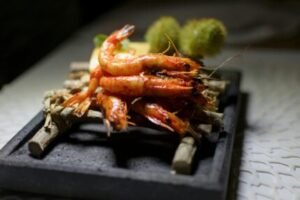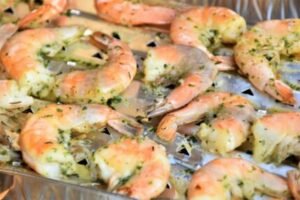Medically reviewed by Dr. Ramesh Gaddam, M.D. — Written by Sumalatha, D.N.H.E
Table of Contents
ToggleShrimp shells are usually thrown away, but some people wonder if they’re safe and healthy to eat.
These shells contain nutrients like fiber and minerals that could offer health benefits, such as helping digestion and supporting bones.
However, they’re tough to chew and digest, and they may not be suitable for everyone, especially people with allergies or sensitive stomachs.
In this article, we’ll explore whether eating shrimp shells is healthy, safe, and worth adding to your diet.
1. Nutritional Profile of Shrimp Shells
Shrimp shells might look simple, but they have some interesting nutrients.
They contain chitin, a type of fiber that can support digestion, and minerals like calcium and phosphorus, which are good for bones.
Shrimp shells also have antioxidants, which help protect cells in the body.
Although these shells aren’t as nutrient-rich as shrimp meat, they still offer a few benefits that may be worth considering if prepared and eaten properly.
| Nutrient | Amount per 100g of Shrimp Shells | Benefits |
|---|---|---|
| Calories | 20-40 kcal | Low in calories |
| Protein | 10-15 g | Supports muscle and tissue health |
| Chitin | 25-30 g (approx.) | Aids digestion and gut health |
| Calcium | 100-150 mg | Essential for strong bones and teeth |
| Phosphorus | 40-70 mg | Supports bone health and energy production |
| Iron | 1-2 mg | Important for blood health and oxygen transport |
| Magnesium | 10-20 mg | Helps with muscle and nerve function |
| Antioxidants | Varies (various compounds) | Protects cells from |
2. Health Benefits of Eating Shrimp Shells
Eating shrimp shells may offer some helpful health benefits.
- Supports Digestion: The fiber in shrimp shells, known as chitin, can aid digestion by helping food move smoothly through your system.
- Strengthens Bones and Joints: Shrimp shells contain calcium and phosphorus, minerals that support healthy bones and joints.
- Boosts Immunity: Antioxidants in shrimp shells help protect the body, supporting a stronger immune system.
- Helps with Weight Control: The fiber in shrimp shells can make you feel fuller, helping to manage weight by reducing hunger.
While these benefits are promising, remember to prepare shrimp shells properly for the best results.
3. Is It Safe to Eat Shrimp Shells?
Eating shrimp shells can be safe, but there are a few things to keep in mind.
People with shellfish allergies should avoid shrimp shells, as they can trigger allergic reactions.
Shrimp shells are tough and may be difficult to digest, especially for people with sensitive stomachs, causing discomfort.
Cooking methods like roasting or boiling can make shells easier to chew and digest. Grinding them into a fine powder can also reduce digestive issues while adding nutrients to dishes.
With proper preparation, shrimp shells can be safely enjoyed, but it’s essential to be mindful of these precautions.
4. How to Prepare Shrimp Shells for Eating?
If you want to try eating shrimp shells, there are some easy ways to prepare them:
Cooking shrimp with the shells on, by roasting, frying, or boiling, makes the shells crispy and easier to eat.
Use a food processor to turn shrimp shells into a fine powder. You can sprinkle this on soups, salads, or other dishes for a boost of nutrients.
Boil shrimp shells in water to make a flavorful broth. This way, you enjoy the nutrients in the shells without eating the tough parts.
With these methods, shrimp shells can be a tasty addition to meals while providing some health benefits.
5. Shrimp Shell Supplements
If eating shrimp shells isn’t appealing, shrimp shell supplements might be an option.
These supplements contain chitin, a fiber found in shrimp shells, and are often used to support digestion and joint health.
They can be taken as pills or powders, making it easy to add the benefits of shrimp shells to your diet without eating them directly.
However, it’s best to talk with a healthcare provider before starting any new supplement, especially if you have allergies.
6. Side Effects and Precautions
While shrimp shells have benefits, they may also have some side effects:
Digestive Discomfort:
The hard texture of shrimp shells can cause bloating or discomfort for some people, especially if eaten in large amounts.
Heavy Metals:
Some shrimp may contain small amounts of heavy metals, which can build up in the body over time.
Eating shrimp shells occasionally is unlikely to cause issues, but frequent consumption could be a concern.
Allergy Risks:
Shrimp shells are unsafe for people with shellfish allergies, as they can cause allergic reactions.
To enjoy shrimp shells safely, eat them in moderation and avoid them if you have any allergies or digestive issues.
7. Who Should Avoid Eating Shrimp Shells?
While shrimp shells offer some benefits, they aren’t suitable for everyone:
Shrimp shells can trigger allergic reactions, so anyone with a shellfish allergy should avoid them entirely.
The hard texture of shrimp shells can be tough on the digestive system, so people with digestive issues or sensitive stomachs might experience discomfort.
Shrimp shells can sometimes contain trace amounts of heavy metals, so it’s safest for pregnant or breastfeeding women to avoid them.
If any of these apply to you, it’s better to skip shrimp shells to avoid possible risks.
8. Culinary Uses of Shrimp Shells
Shrimp shells might seem like waste, but they can be used in various delicious ways.
Here are some culinary uses for shrimp shells:
1. Broth or Stock
Shrimp shells can be boiled to make a flavorful broth. Simply simmer the shells with water, onions, garlic, and herbs for about 30 minutes.
This broth can be used as a base for soups, stews, or sauces.
2. Flavoring for Rice
Add shrimp shells to the water when cooking rice to give it a rich seafood flavor.
Just strain out the shells before serving.
This adds a subtle taste that enhances the dish.
3. Seasoning for Dishes
Crushed shrimp shells can be used as a seasoning.
Dry the shells and grind them into a powder.
Sprinkle this on seafood dishes, salads, or popcorn for a unique flavor boost.
4. Grilling or Roasting
When grilling shrimp, leave the shells on to keep the shrimp moist and flavorful.
The shells help trap juices and add depth to the taste during cooking.
5. Enhancing Sauces
You can simmer shrimp shells in sauces to enrich the flavor. Just remove the shells before serving.
This works well in sauces for pasta, seafood, or even in marinades.
6. Adding Crunch
For a fun texture, fry shrimp shells until crispy.
These can be used as a crunchy topping for salads, soups, or tacos, adding both flavor and a unique twist.
7. Stuffing for Dishes
In some recipes, the shells can be used to stuff seafood dishes.
For example, you can fill the shells with a mixture of shrimp, herbs, and breadcrumbs and bake them for a tasty appetizer.
Conclusion
Eating shrimp shells can add fiber and minerals to your diet, supporting digestion, bones, and immune health.
However, shrimp shells can be hard to digest, especially for people with allergies or sensitive stomachs.
Preparing them by cooking or grinding helps make them easier to eat and adds flavor to meals.
Overall, shrimp shells can be a nutritious choice when eaten in moderation and with the right preparation.
Always consider your own health needs and consult a healthcare provider if unsure.
Frequently Asked Questions (FAQs)
Is Peel and Eat Shrimp Safe to Eat?
Yes, peel and eat shrimp are safe to eat as long as they are cooked properly.
Make sure the shrimp is fresh and cooked until it turns pink and opaque.
Avoid eating raw shrimp to reduce the risk of foodborne illnesses.
What Part of Shrimp Do You Not Eat?
The parts of shrimp that are typically not eaten include the head, shell, and tail.
While some people enjoy eating the shells, the hard parts can be tough to chew.
The head contains some flavor but is often removed before serving.
Can You Eat the Whole Shrimp?
You can eat the whole shrimp if you choose to, including the shell.
However, many people prefer to remove the shell and tail for easier eating.
Cooking shrimp with the shells on can add extra flavor to dishes.
Is Shrimp Better with or Without the Shell?
Shrimp can be enjoyed both with and without the shell.
Eating shrimp with the shell can enhance the flavor and add nutrients, while removing the shell makes it easier to eat.
It ultimately depends on personal preference.
Is Eating Shrimp Shell Good for You?
Eating shrimp shells can be good for you because they contain fiber, minerals, and antioxidants.
The fiber can help with digestion, while minerals like calcium and phosphorus support bone health.
However, be sure to prepare them properly for easier digestion.
What Is the Healthiest Way to Eat Shrimp?
The healthiest way to eat shrimp is to grill, steam, or boil them rather than frying.
These cooking methods keep shrimp low in calories and fat.
Pairing shrimp with vegetables or whole grains can also make for a balanced meal.
Is Shrimp Healthier Than Chicken?
Shrimp can be considered healthier than chicken in some ways.
It is lower in calories and saturated fat while providing high-quality protein and essential nutrients.
However, the healthiest option depends on individual dietary needs and preferences.
Is Shrimp Bad for Your Cholesterol?
Shrimp has some cholesterol, but it is low in saturated fat.
For most people, eating shrimp in moderation does not significantly affect cholesterol levels.
However, those with specific health conditions should consult a healthcare provider for personalized advice.
What Foods Not to Eat with Shrimp?
Avoid pairing shrimp with heavy, greasy foods, such as fried items or creamy sauces, as these can lead to an unhealthy meal.
It’s also best to limit mixing shrimp with foods high in oxalates, like spinach, which can affect nutrient absorption.
Instead, enjoy shrimp with fresh vegetables, whole grains, or light sauces for a healthier option.
Is It Better to Buy Peeled or Unpeeled Shrimp?
Whether to buy peeled or unpeeled shrimp depends on your preference and how you plan to use them.
Peeled shrimp are convenient and ready to cook, making them a quick option for meals.
Unpeeled shrimp, on the other hand, can be more flavorful and retain moisture during cooking, but they require more preparation time.
Are You Supposed to Take the Shell Off Shrimp?
It’s common to remove the shell from shrimp before eating, especially when they are served as a main dish.
However, some people enjoy eating shrimp with the shell on for added flavor and nutrients.
Ultimately, it’s up to personal preference.
Are You Supposed to Eat Shrimp with the Shell Still On?
You can eat shrimp with the shell still on, but it’s not common in most settings.
Eating shrimp with the shell can add flavor, but the shells can be tough to chew.
Many people choose to peel the shrimp before eating for ease.
Is Shrimp Better with Tail On or Off?
Shrimp can be served with the tail on or off, depending on how you plan to eat them.
Keeping the tail on can enhance presentation and flavor, while removing it makes for easier eating.
Many people prefer to remove the tail before serving for convenience.
Why Do Restaurants Cook Shrimp with Shells On?
Restaurants often cook shrimp with the shells on to enhance flavor and moisture.
The shells can add a rich taste to dishes, and cooking them this way helps keep the shrimp tender.
It also makes for an appealing presentation.
How Can You Tell if Shrimp Are Healthy?
To tell if shrimp are healthy, look for fresh, firm shrimp with a mild, ocean-like smell.
Avoid shrimp that have a strong fishy odor or are slimy.
Fresh shrimp should have a slightly translucent appearance and not be discolored.
Why Do People Leave the Shrimp Tail On?
People often leave the shrimp tail on for presentation and flavor.
The tail can add a decorative touch to dishes and may enhance the overall taste.
Leaving the tail on can also make it easier to pick up the shrimp with fingers when serving.
Is It Safe to Eat Shrimp Tails?
Eating shrimp tails is generally safe, but they can be tough and hard to chew.
Some people enjoy them for added flavor and texture, while others prefer to remove them for easier eating.
If you choose to eat them, ensure they are properly cooked.
What Not to Mix Shrimp With?
Avoid mixing shrimp with heavy or greasy foods, such as fried items or rich sauces, as these can create an unbalanced meal.
It’s also best to limit combining shrimp with foods high in oxalates, like spinach, which can interfere with nutrient absorption.
How Long to Cook Shrimp?
Cooking shrimp usually takes about 2 to 5 minutes, depending on the size and cooking method.
Shrimp should be cooked until they turn pink and opaque.
Avoid overcooking, as this can make them tough and rubbery.
For best results, use a timer to monitor cooking time.
Also Read:
Fish and Curd: Can we eat both together? (7 Facts & Myths)
Medically reviewed by Dr. Ramesh Gaddam, M.D.

General Physician, Diabetologist, and Critical Care Specialist.
Related
Discover more from Health Build-Up
Subscribe to get the latest posts sent to your email.






